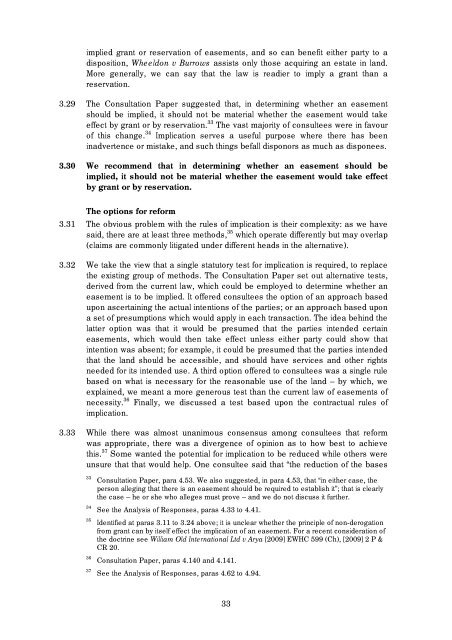Making Land Work: Easements, Covenants and ... - Law Commission
Making Land Work: Easements, Covenants and ... - Law Commission
Making Land Work: Easements, Covenants and ... - Law Commission
You also want an ePaper? Increase the reach of your titles
YUMPU automatically turns print PDFs into web optimized ePapers that Google loves.
implied grant or reservation of easements, <strong>and</strong> so can benefit either party to a<br />
disposition, Wheeldon v Burrows assists only those acquiring an estate in l<strong>and</strong>.<br />
More generally, we can say that the law is readier to imply a grant than a<br />
reservation.<br />
3.29 The Consultation Paper suggested that, in determining whether an easement<br />
should be implied, it should not be material whether the easement would take<br />
effect by grant or by reservation. 33 The vast majority of consultees were in favour<br />
of this change. 34 Implication serves a useful purpose where there has been<br />
inadvertence or mistake, <strong>and</strong> such things befall disponors as much as disponees.<br />
3.30 We recommend that in determining whether an easement should be<br />
implied, it should not be material whether the easement would take effect<br />
by grant or by reservation.<br />
The options for reform<br />
3.31 The obvious problem with the rules of implication is their complexity: as we have<br />
said, there are at least three methods, 35 which operate differently but may overlap<br />
(claims are commonly litigated under different heads in the alternative).<br />
3.32 We take the view that a single statutory test for implication is required, to replace<br />
the existing group of methods. The Consultation Paper set out alternative tests,<br />
derived from the current law, which could be employed to determine whether an<br />
easement is to be implied. It offered consultees the option of an approach based<br />
upon ascertaining the actual intentions of the parties; or an approach based upon<br />
a set of presumptions which would apply in each transaction. The idea behind the<br />
latter option was that it would be presumed that the parties intended certain<br />
easements, which would then take effect unless either party could show that<br />
intention was absent; for example, it could be presumed that the parties intended<br />
that the l<strong>and</strong> should be accessible, <strong>and</strong> should have services <strong>and</strong> other rights<br />
needed for its intended use. A third option offered to consultees was a single rule<br />
based on what is necessary for the reasonable use of the l<strong>and</strong> – by which, we<br />
explained, we meant a more generous test than the current law of easements of<br />
necessity. 36 Finally, we discussed a test based upon the contractual rules of<br />
implication.<br />
3.33 While there was almost unanimous consensus among consultees that reform<br />
was appropriate, there was a divergence of opinion as to how best to achieve<br />
this. 37 Some wanted the potential for implication to be reduced while others were<br />
unsure that that would help. One consultee said that “the reduction of the bases<br />
33 Consultation Paper, para 4.53. We also suggested, in para 4.53, that “in either case, the<br />
person alleging that there is an easement should be required to establish it”; that is clearly<br />
the case – he or she who alleges must prove – <strong>and</strong> we do not discuss it further.<br />
34 See the Analysis of Responses, paras 4.33 to 4.41.<br />
35 Identified at paras 3.11 to 3.24 above; it is unclear whether the principle of non-derogation<br />
from grant can by itself effect the implication of an easement. For a recent consideration of<br />
the doctrine see William Old International Ltd v Arya [2009] EWHC 599 (Ch), [2009] 2 P &<br />
CR 20.<br />
36 Consultation Paper, paras 4.140 <strong>and</strong> 4.141.<br />
37 See the Analysis of Responses, paras 4.62 to 4.94.<br />
33
















